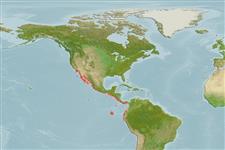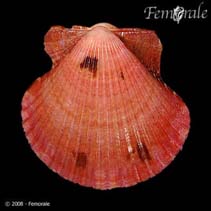Argopecten ventricosus (Sowerby II, 1842)
Pacific calico scallop| Native range | All suitable habitat | Point map | Year 2050 |

|
| This map was computer-generated and has not yet been reviewed. |
| Argopecten ventricosus AquaMaps Data sources: GBIF OBIS |
Classification / Names Common names | Synonyms | CoL | ITIS | WoRMS
Bivalvia | Pectinida | Pectinidae
Environment: milieu / climate zone / depth range / distribution range Ecology
Benthic; brackish; depth range 0 - 180 m (Ref. 114555). Subtropical, preferred 26°C (Ref. 107945); 35°N - 6°S, 121°W - 77°W (Ref. 114555)
Distribution Countries | FAO areas | Ecosystems | Occurrences | Introductions
Eastern Pacific: From California, USA (35°N) and the Gulf of California to Piura, Peru (6°S).
Length at first maturity / Size / Weight / Age
Maturity: Lm ? range ? - ? cm Max length : 10.0 cm SHL male/unsexed; (Ref. 101476)
Inhabits shallow bays, sloughs and calm offshore areas; often associated with eelgrass beds. Moves by expelling water between valves propelling to a distance of 1m upwards or several meters sideways, i.e., flying motion. Smaller scallops are generally attached to the substrate by byssal threads (Ref. 78081). Commercial scallop fishery in early 1900s overexploited this resource, the fishery fell in the 1950s and the once abundant scallop became rare along the northern range of its distribution. This led to the protection of this species by the California Fish and Game Commission in 1954 (Ref. 78082). Commercial scallop fisheries and aquaculture exist in Baja California Sur, Mexico both on Pacific and Gulf of California areas since the 1980s (Ref. 78088) with peak catches at Magdalena Bay in 1990 accounting for 53% of total Mexican scallop production (Ref. 78090).
Life cycle and mating behavior Maturity | Reproduction | Spawning | Eggs | Fecundity | Larvae
Members of the class Bivalvia are mostly gonochoric, some are protandric hermaphrodites. Life cycle: Embryos develop into free-swimming trocophore larvae, succeeded by the bivalve veliger, resembling a miniature clam.
Main reference
References | Coordinator | Collaborators
Waller, T.R. 1995. (Ref. 78082)
IUCN Red List Status (Ref. 130435)
CITES status (Ref. 108899)
Not Evaluated
CMS (Ref. 116361)
Not Evaluated
Threat to humans
Harmless
Human uses
Fisheries: commercial; aquaculture: commercial
FAO - Aquaculture: production; Fisheries: landings | FishSource | Sea Around Us
Tools
More information
Age/Size
Growth
Length-weight
Length-length
Morphology
Larvae
Abundance
Growth
Length-weight
Length-length
Morphology
Larvae
Abundance
Internet sources
BHL | BOLD Systems | CISTI | DiscoverLife | FAO(Fisheries: ; publication : search) | Fishipedia | GenBank (genome, nucleotide) | GloBI | Gomexsi | Google Books | Google Scholar | Google | PubMed | Tree of Life | Wikipedia (Go, Search) | Zoological Record
Estimates based on models
Preferred temperature
(Ref. 115969): 11 - 28.5, mean 24 (based on 90 cells).
Nutrients: Calcium = 149 [71, 228] mg/100g; Iron = 8.53 [1.95, 15.11] mg/100g; Protein = 9.88 [8.64, 11.12] %; Omega3 = 0.313 [0.202, 0.423] g/100g; Selenium = 61 [50, 72] μg/100g; VitaminA = 0 μg/100g; Zinc = 2.04 [0.56, 3.51] mg/100g (wet weight).



